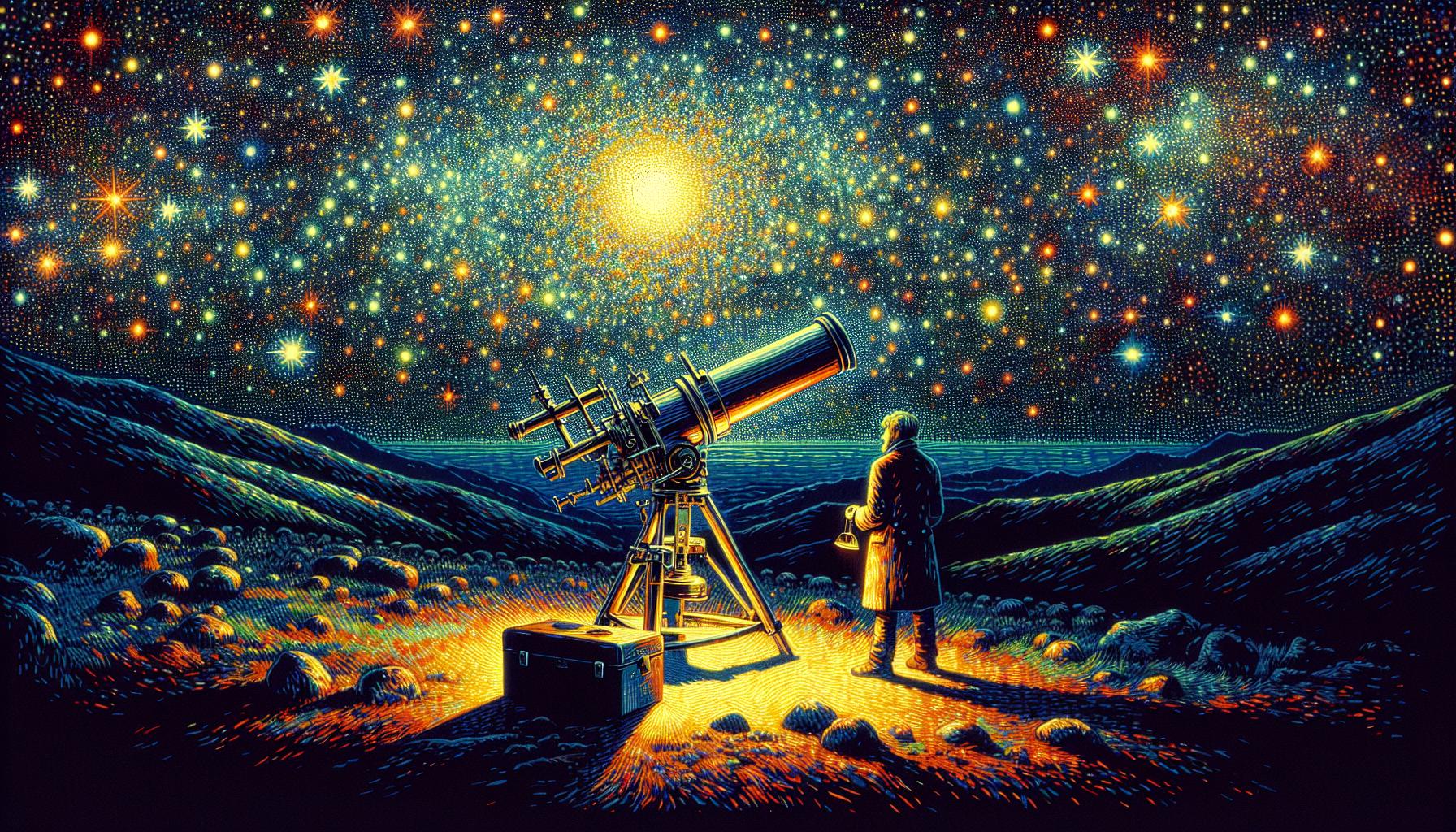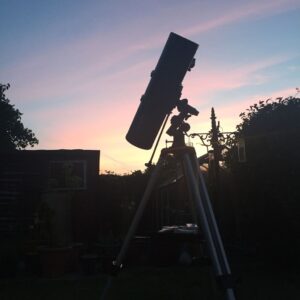This site contains affiliate links to products. I may receive a commission for purchases made through these links.
I’m an astronomy enthusiast and over the years, I’ve developed a special fondness for the dobsonian telescope with an equatorial mount. It’s a game-changer for stargazers, offering a perfect blend of simplicity and functionality.
This telescope type combines the easy-to-use features of a dobsonian with the precision tracking of an equatorial mount. It’s the ideal choice for those keen on deep-sky observations.
The dobsonian’s design allows for large aperture sizes, while the equatorial mount provides accurate tracking of celestial objects. This combination makes it a powerful tool in the hands of both amateur and experienced astronomers.
What is a Dobsonian Telescope?
The Dobsonian telescope, named after its creator, John Dobson, has become a popular choice among amateur astronomers. Dobson, a monk with an extensive interest in astrophysics, wanted to create a telescope that was affordable, sturdy, and able to capture more light than conventional telescopes of the day. And that’s just what he did.
Constructed with a simple mount made of common materials such as plywood, Dobsonian telescopes are renowned for their stability. They’re typically considered Altitude-Azimuth (Alt-Az) telescopes, basing their movement on either the vertical or horizontal axis. This allows for an intuitive ‘up-down, left-right’ type movement pattern, so novice astronomers can easily aim the telescope and navigate through the night sky.
But what sets a Dobsonian apart most dramatically is its capacity for large apertures. This kind of scope can house mirrors that are substantially larger than those found in typical telescopes – and bigger mirrors mean better images. A large mirror collects more light and in turn can reveal more detail in deep-sky objects. Everything from vast galaxies to nebulous gas clouds can be viewed with exceptional clarity with a Dobsonian.
That being said, while the Dobsonian model is quite user-friendly and provides intricate views of the cosmos, it has its limitations. It’s this recognition of room for improvement that led to the incredibly effective combination of the Dobsonian telescope with an equatorial mount.
Well, an understanding of the Dobsonian telescope is key in appreciating why combining it with an equatorial mount can be such a game-changer. We’ll explore this idea further in the next section – The Power of an Equatorial Mount.
Understanding Equatorial Mounts
Now let’s take a deeper dive into what Equatorial mounts are all about and why they’re often paired with the Dobsonian telescope. To appreciate this blend, it’s important to understand the unique characteristics of an Equatorial mount.
An Equatorial mount, in simplest terms, is a type of mount used for tracking celestial objects in the night sky – a crucial feature for the stargazing enthusiasts among us. This mount’s genius lies in its ability to compensate for Earth’s rotation by having one rotational axis parallel to the Earth’s axis of rotation. Essentially, it tracks stars, planets, and other celestial entities as they move across the sky.
Equatorial mounts are also known for their use in astrophotography, the practice of taking photos of the night sky. The consistency and precision of these mounts make it easier to take long exposure photos without star trails, a common problem when using a basic mount.
Beyond that, these mounts come in two types:
- German Equatorial Mount (GEM): GEMs are most recognized for their greater stability and weight capacity. They can hold larger telescopes, making them perfect for observing deep-space objects like galaxies, nebulae, and star clusters. Their design allows the weight of the telescope to be evenly distributed, bringing stability to the overall setup.
- Fork-Mounted Equatorial Mount: Fork-mounted versions are easier to use and generally more affordable. They may not have the same weight capacity as a GEM, but they’re suitable for smaller, lighter telescopes.
Pairing a Dobsonian telescope with an Equatorial mount results in a high-powered observational instrument. This combination brings together the Dobsonian’s power for capturing vast amounts of light with the precision and control provided by the Equatorial mount. In the following section, we’ll delve into the specifics of this combination, exploring its strengths and challenges.
Advantages of the Dobsonian Telescope with Equatorial Mount
When it comes to amateur astronomy, stability and light capture top the chart in terms of features desired in a telescope. That’s where a Dobsonian telescope takes the lead. Yet, Dobsonian’s potential escalates when coupled with an equatorial mount. This combo enhances precision while observing celestial bodies.
One significant advantage is the increased power and precision that comes with utilizing an equatorial mount. Remember, viewing celestial objects requires not only raw power but also finely tuned precision. The equatorial mount, whether it’s a German Equatorial Mount (GEM) or Fork-Mounted, offers these qualities. It’s geared to precisely follow the motion of the stars as the Earth rotates. That gives me finer control to track and observe astronomical objects.
In the domain of astrophotography, an equatorial mount aligns its rotation axis parallel to that of the Earth. This alignment results in a smooth tracking of celestial objects, minimizing the likelihood of blurring your images due to Earth’s rotation. Astrophotography demands prolonged exposures, and the mount’s tracking ability ensures crisp, clear snapshots of galaxies far away.
Additionally, let’s not forget the elements of ease of use and portability. Dobsonian telescopes with equatorial mounts are typically user-friendly, even for the novices in amateur astronomy. The setup process isn’t overly complicated, and the mount’s smooth motion makes operation a breeze. These designs also keep portability in mind, most are collapsible or disassemble easily for transport.
To sum it up, equipping a Dobsonian telescope with an equatorial mount amplifies the instrument’s strength. It brings greater precision, enhanced tracking efficiencies, and a user-friendly experience, improving overall astronomical observations. We’ll delve deeper into these aspects in the subsequent sections, comparing them against other telescope and mount combinations.
Choosing the Right Dobsonian Telescope with Equatorial Mount
When it comes to choosing the right Dobsonian telescope with an equatorial mount, there are several factors to consider. Let’s delve a bit more into it.
First off, understand your objectives. Whether it’s astrophotography, deep sky observation, or simply stargazing, knowing what you need from your telescope will help shape your decision.
Size is another factor. Dobsonian telescopes come in different sizes. The size of the scope highly influences both power and portability. Larger scopes provide more detailed and brighter observations but can be a challenge to move around.
Then, consider the mount. I can’t stress enough how vital the mount is. As we’ve discussed, an equatorial mount improves precision and helps a lot in astrophotography. But make sure to check its quality and stability. A substandard mount will defeat the purpose.
Lastly, don’t overlook the price! Telescopes vary widely in cost, affected mainly by brand, size, and additional features like computerization. Remember, it’s about finding the balance of affordability and quality to suit your needs.
Here’s a simplified rundown:
| Considerations | What to Look For |
|---|---|
| Objective | Whether intended for astrophotography, deep sky observation or casual stargazing. |
| Size | Larger telescopes provide more detailed observations but sacrifice portability. |
| Mount Quality | A stable and high-quality mount is crucial especially for precision and astrophotography. |
| Price | Telescopes vary widely in cost. It’s a balance between affordability and quality. |
In a world of numerous options and flashy advertisements, picking the right gear can seem daunting. But once you know what you’re looking for, choosing the perfect Dobsonian telescope with an equatorial mount becomes significantly easier. Trust me, that perfect starry night is well worth the search.
Tips for Using a Dobsonian Telescope with Equatorial Mount
Getting your hands on a magnificent piece of astronomical equipment such as a Dobsonian Telescope with an equatorial mount can be thrilling. But it’s more than just about having it – knowing how to use it correctly is the real deal. Here are some useful tips.
First off, it’s all about location. Find an area with low light pollution to maximize your viewing experience. Cities or areas with heavy artificial lighting might not give you a clear view of the stars or other celestial objects.
Next, understand the crux of using an equatorial mount. The mount should align with the North or South Pole. This alignment allows you to follow an object’s path easily as it moves across the sky.
Understanding your telescope’s specific features is vital too. Your Dobsonian model might have subtle differences from other models in terms of adjustments and eye relaxation distances. Don’t hesitate to refer to the user manual for specific methods to manage these slight differences.
Lastly, recall the importance of stabilizing the mount that was discussed earlier in this article. A shaky mount can be the downfall of a fantastic viewing experience. So, ensure your mount is set-up on a solid base and avoid windy conditions.
Maintaining your Dobsonian Telescope with an equatorial mount can save you costly repairs too. Ensure regular cleaning, particularly of the optics and the mount. Use a non-abrasive, lint-free cloth for this task. Reduction of moisture is key in maintaining the longevity of the lens, so consider using lens caps when not in use.
As you start practicing with your new Dobsonian Telescope with an equatorial mount, remember these tips, and you’ll notice your skills exponentially improving! And with time, even a novice amateur astronomer can produce scientifically valuable observations.
Conclusion
So there you have it. Harnessing the power of a Dobsonian telescope with an equatorial mount isn’t rocket science. By choosing a location with minimal light pollution and aligning the mount correctly, you’re already halfway to unlocking the cosmos. Familiarizing yourself with your telescope’s unique features and ensuring it’s stable will further enhance your viewing experience. Don’t forget that regular upkeep is key.
Clean optics and the use of lens caps to prevent moisture buildup will keep your telescope in top shape. With these tips in your arsenal, you’re well on your way to making valuable astronomical observations, even if you’re just starting out. The universe is out there, waiting for you to explore.
Don’t forget to subscribe to our newsletter where you’ll find the latest cosmic discoveries, expert stargazing tips, and exclusive subscriber deals. Embark on your cosmic journey if you haven’t already!
Happy stargazing!



